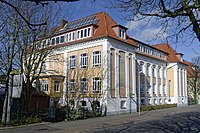Dike school
The Deichschule ( Deichstrasse School ) in Cuxhaven , Deichstrasse 12b, has existed since 1878 and has been the Cuxhaven Waldorf School since 2005 . The building is under the protection of historical monuments in Lower Saxony and is entered in the list of architectural monuments in Cuxhaven .
history
Cuxhaven School
In 1872 Ritzebüttel and Cuxhaven were united as one rural community. Then the (large) Cuxhaven school was built by the Hamburg Senate according to plans by the architects Gustav Jakob Kirchenpauer and Philipp as the first central community school in Cuxhaven by 1878 . The two-storey historicizing U-shaped building with a high base and a (not preserved) square clock tower with a lantern and a bell dome was built on the moist Commandeurswiese, which is centrally located for both districts, above a filled wehle (scouring) on Deichstrasse . The building ground had to be replaced by sandy soil. The hipped roof, which was flat at the time, was later replaced by a higher hipped roof with elongated dormers in order to set up rooms in the attic.
The school initially had 530 students in six boys 'and four girls' classes, who were taught by eight teachers. The school fee was 10 to 26 marks .
In 1881 it became a secondary school (senior department or principal school ) for the boys and a state secondary school for girls . Instead of the church, the congregation was responsible for the school supervision. After 1898, the higher public school was established in the Rohde road here was elementary school housed for girls and boys and in the evening took lessons for further training instead (training school) . In 1905 the gym was built.
Dike school
In 1907 the school was again an all girls' school; the boys came to the new Abendroth school . In 1913 it received central heating. From 1919 to 1967 it was called Deichschule as a uniform school for girls - the Weimar Constitution had made compulsory schooling in Germany mandatory from 1919 .
In 1967, the Johann-Hinrich-Wichern School ( Wichernschule for short ), a special school (later a special needs school), which until then had been housed in the Bleickenschule building, came into the building . The school director was Hermann Borrmann , who was head of the Cuxhaven City Archives from 1972 to 1989 . An extensive renovation of the building was necessary in 1998 in order to stabilize the foundation of the foundations. A planned extension was not implemented.
Free Waldorf School
In 2005 the Free Waldorf School rented the house through the school association Freie Waldorfschule Cuxhaven . The school currently (2020) has 12 classes. In addition to the classrooms, there is a sports hall, a swimming pool, rooms for languages, music, for the band, art, plasticizing, handicraft, sewing, works, eurythmy , physics, chemistry, dancing, Schnürboden , as well as a hall and the school garden. The school uses the 12-meter-long friendship from Finkenweder from 1984 and offers a nautical internship.
The idea of Waldorf education : After the horrors of the First World War , the anthroposophist Rudolf Steiner endeavored to set up a “contemporary school in cultural, economic and social life”. The director of the Waldorf-Astoria cigarette factory Emil Molt founded the first Waldorf school in Stuttgart in 1919 for his workers and their children . According to Steiner's principles and under his direction, the concept of a comprehensive school was implemented; five more schools followed, which were closed in 1936. Between September 1945 and 2017, 240 Waldorf schools were established in Germany.
literature
- Peter Bussler: Historical city lexicon for Cuxhaven . Ed .: Heimatbund der Männer vom Morgenstern, 2002.
Web links
Individual evidence
- ↑ Cuxpedia: dike school
Coordinates: 53 ° 51 '54.8 " N , 8 ° 42' 2.7" E

